Exploring the Spatial Coupling Characteristics and Influence Mechanisms of Built Environment and Green Space Pattern: The Case of Shanghai
Abstract
1. Introduction
2. Materials and Methods
2.1. Study Area
2.2. Data Sources and Preprocessing
2.3. Construction of Research Indicators
2.3.1. Attention Mechanism and Deep Neural Network (DNN) for Weight Calculation
2.3.2. K-Means Clustering Analysis
- Dispersed Natural Zone: Low in both urban and ecological development; includes scattered natural areas like wetlands and grasslands with weak spatial integration.
- Urban Dominated Coordination Zone: High built environment intensity with moderate green land support; coordination is maintained through compact development and vertical greening.
- Green-Oriented Transition Zone: Rich in green space but underdeveloped in urban infrastructure; low coordination reflects untapped synergy potential.
2.3.3. Nonlinear Modeling and Interpretation
2.4. Research Technical Framework Roadmap
3. Results
3.1. Spatial Distribution Characteristics of the Comprehensive Indices for Built Environment and Green Space Pattern
3.2. Spatial Clustering Patterns and Coupling Relationship Identification
3.3. Mechanism Analysis of Influencing Factors
3.3.1. Overall Feature Importance Analysis
3.3.2. Threshold Effects
4. Discussion
4.1. Spatial Distribution of Built Environment and Green Space Patterns
4.2. Coupling Relationships and Spatial Clustering
4.3. Policy Recommendations
4.3.1. Zonal Differentiation and Tailored Spatial Governance Mechanisms
- In the Urban Dominant Coordination Zone, due to its high coupling coordination, high-density built environment, and strong green space compensation characteristics, the future planning of the core area should prioritize enhancing the layered integration and multifunctional use of green infrastructure. In contrast, the surrounding areas with low coordination should focus on green space development. During the construction process, reference should be made to the threshold effects of indicator thresholds to set corresponding thresholds for each green space development, ensuring that construction achieves the optimal coordination range. Additionally, the promotion of vertical greening, rooftop gardens, and pocket parks is encouraged to facilitate micro-ecological renewal and quality improvement in densely populated urban core areas [93,94]. Simultaneously, protecting urban ecological red lines and achieving a sustainable development model that combines high-density built environments with green penetration is of critical importance. Taking Singapore as an example, the city implemented the “City in a Garden” strategy under extremely limited land resources and widely applied measures such as green roofs, three-dimensional green walls, and sky gardens. Since the launch of the “Skyrise Greenery Incentive Scheme” in 2009, Singapore has constructed over 100 hectares of green roofs and vertical greening as of 2023, effectively alleviating the urban heat island effect and improving air quality.
- The Green-Oriented Transition Zones possess substantial green space resources but relatively underdeveloped built environments, resulting in moderate coupling coordination. In this zone, emphasis should be placed on preserving green space patterns and integrating urban development with green space planning to avoid fragmented urban sprawl that undermines existing ecological configurations. Priority should be given to planning green space, protecting ecological land, and constructing ecological corridors to enhance its ecological reserve function and support a smooth transition towards green and low-carbon urban districts [95].
- The Dispersed Natural Zone is primarily composed of ecologically sensitive landscapes such as wetlands, grasslands, and water bodies, characterized by low built environment intensity and fragmented spatial distribution. Rather than reflecting development–ecology conflict, its low coupling coordination degree stems from minimal urban integration and functional disconnection. Therefore, planning in this zone should emphasize ecological protection over urban expansion. Strategic priorities include maintaining ecological integrity through strict land-use controls and redline enforcement, enhancing habitat quality via targeted ecological restoration, and improving spatial connectivity by integrating these dispersed patches into broader green space networks [96]. Where minimal development is unavoidable, eco-sensitive design and nature-based solutions should be adopted to ensure that ecological functions are not compromised. This approach ensures that the zone serves as a resilient ecological reserve, supporting regional biodiversity and landscape sustainability.
4.3.2. Urban Expansion Guidance and Institutional Support
5. Conclusions
5.1. The Main Conclusions of This Study
- (1)
- There are significant spatial differences between the built environment and green space patterns. High values of the Built Environment Index (BEI) are concentrated in central urban areas, while high values of the Green Space Pattern Index (GSPI) are predominantly distributed in peripheral ecological zones, revealing the typical contradiction between the expansion of urban grey infrastructure and the retreat of green spaces.
- (2)
- The coupling coordination degree (CCD) exhibits obvious spatial heterogeneity. Areas with high built environments and moderate green space patterns (such as urban core areas) demonstrate higher coordination levels, while areas rich in ecological resources but underdeveloped built environments show lower coordination levels. Peripheral areas with fragmented infrastructure and incomplete green space layouts exhibit the lowest coupling coordination degree.
- (3)
- K-Means clustering analysis identified three main spatial types, which were analyzed in conjunction with coupling coordination degree and the spatial heterogeneity of built environment and green space patterns to examine the characteristics of different spatial types. These are: first, the Urban Dominant Coordination Zone, characterized by dense built environment and well-developed green space configuration, exhibiting mature coordination mechanisms; second, the Green-Oriented Transition Zone, rich in ecological resources but with weak built environment, offering significant development potential but low coordination levels; Third, the Dispersed Natural Zone: both built environment and green space pattern indices are low, with minimal ecological intervention, presenting a natural preservation state.
- (4)
- Machine learning analysis based on LightGBM and SHAP indicates that structural indicators of the built environment (such as average compactness, weighted height, and land use diversity) are the primary drivers of coupling coordination, while green space pattern indicators, though ecologically significant, have a relatively minor influence in the model.
5.2. Limitations and Future Research
Author Contributions
Funding
Data Availability Statement
Acknowledgments
Conflicts of Interest
Correction Statement
References
- Chan, C.K.; Yao, S.M. Urbanization and sustainable metropolitan development in China: Patterns, problems and prospects. GeoJournal 1999, 49, 269–277. [Google Scholar] [CrossRef]
- Liu, F.; Zhang, Z.X.; Zhang, X.L.; Liu, B.; Wang, X.; Yi, L.; Zuo, L.J.; Xu, J.Y.; Hu, S.G.; Sun, F.F.; et al. Urban expansion of China from the 1970s to 2020 based on remote sensing technology. Chin. Geogr. Sci. 2021, 225, 765–781. [Google Scholar] [CrossRef]
- Peng, L.; Huang, K.X.; Zhang, H.J.; Sun, W. Exploring the impacts of urbanization on vegetation growth from the perspective of urban expansion patterns and maturity: A case study on 40 large cities in China. Sustain. Cities Soc. 2024, 115, 105841. [Google Scholar] [CrossRef]
- Wu, J.; Yang, S.; Zhang, X. Interaction analysis of urban blue-green space and built-up area based on coupling model—A case study of Wuhan central city. Water 2020, 12, 2185. [Google Scholar] [CrossRef]
- Wang, Y.Q.; Chen, S.S.; Zheng, G.H.; Zhou, S.L.; Zhou, Y.J. Risk assessment and zoning of soil microplastics in a typical megacity, China. J. Hazard. Mater. 2025, 495, 138870. [Google Scholar] [CrossRef]
- Hu, Y.N.; Cheng, H.F. Water pollution during China’s industrial transition. Environ. Dev. 2013, 8, 57–73. [Google Scholar] [CrossRef]
- Wang, J.; Zhang, Y.Z.; Zhang, X.L.; Song, M.Q.; Ye, J.P. The spatio-temporal trends of urban green space and its interactions with urban growth: Evidence from the Yangtze River Delta region, China. Land Use Policy 2023, 128, 106598. [Google Scholar] [CrossRef]
- Kabisch, N.; Qureshi, S.; Haase, D. Human–environment interactions in urban green spaces—A systematic review of contemporary issues and prospects for future research. Environ. Impact Assess. Rev. 2015, 50, 25–34. [Google Scholar] [CrossRef]
- Zhao, S.Q.; Da, L.J.; Tang, Z.Y.; Fang, H.J.; Song, K.; Fang, J.Y. Ecological consequences of rapid urban expansion: Shanghai, China. Front. Ecol. Environ. 2006, 4, 341–346. [Google Scholar] [CrossRef]
- Haase, D.; Kabisch, S.; Haase, A.; Andersson, E.; Banzhaf, E.; Baro, F.; Brenck, M.; Fischer, L.K.; Frantzeskaki, N.; Kabisch, N.; et al. Greening cities—To be socially inclusive? About the alleged paradox of society and ecology in cities. Habitat Int. 2017, 64, 41–48. [Google Scholar] [CrossRef]
- Chen, Y.M.; Liu, Z.H.; Zhou, B.B. Population–environment dynamics across world’s top 100 urban agglomerations: With implications for transitioning toward global urban sustainability. J. Environ. Manag. 2022, 319, 115630. [Google Scholar] [CrossRef]
- Qiao, Z.H.; Xu, X.Y.; Zou, W.T.; Huang, Y.L. Urban sustainable development goals and ecosystem services: Pathways to achieving coordination. Land Use Policy 2024, 146, 107317. [Google Scholar] [CrossRef]
- Wang, Y.J.; Shinwari, R.; Payab, A.H.; Feng, J.Y. Harmonizing sustainability: Unveiling the nexus of public private investment, natural resources, and environmental dynamics by applying ARDL and machine learning approach. Ecol. Indic. 2024, 161, 111931. [Google Scholar] [CrossRef]
- Wu, J.G. Urban ecology and sustainability: The state-of-the-science and future directions. Landsc. Urban Plan. 2014, 125, 209–211. [Google Scholar] [CrossRef]
- Huang, Y.Y.; Lin, T.; Zhang, G.Q.; Jones, L.; Xue, X.Z.; Ye, H.; Liu, Y.Q. Spatiotemporal patterns and inequity of urban green space accessibility and its relationship with urban spatial expansion in China during rapid urbanization period. Sci. Total Environ. 2022, 809, 151123. [Google Scholar] [CrossRef]
- Song, X.X.; Liu, Y.Z.; Zhu, X.N.; Cao, G.; Chen, Y.; Zhang, Z.; Wu, D. The impacts of urban land expansion on ecosystem services in Wuhan, China. Environ. Sci. Pollut. Res. 2022, 29, 10635–10648. [Google Scholar] [CrossRef]
- Li, S.N.; He, Y.Y.; Xu, H.L.; Zhu, C.M.; Dong, B.Y.; Lin, Y.; Si, B.; Deng, J.S.; Wang, K. Impacts of urban expansion forms on ecosystem services in urban agglomerations: A case study of Shanghai–Hangzhou Bay urban agglomeration. Remote Sens. 2021, 13, 1908. [Google Scholar] [CrossRef]
- Yang, Y.M.; Zhang, D.; Nan, Y.; Liu, Z.F.; Zheng, W. Modeling urban expansion in the transnational area of Changbai Mountain: A scenario analysis based on the zoned Land Use Scenario Dynamics-urban model. Sustain. Cities Soc. 2019, 50, 101622. [Google Scholar] [CrossRef]
- Wang, K.; Li, Z.Y.; Zhang, J.J.; Wu, X.; Jia, M.; Wu, L. Built-up land expansion and its impacts on optimizing green infrastructure networks in a resource-dependent city. Sustain. Cities Soc. 2020, 55, 102026. [Google Scholar] [CrossRef]
- Chu, M.G.; Lu, J.Y.; Sun, D.Q. Influence of urban agglomeration expansion on fragmentation of green space: A case study of Beijing–Tianjin–Hebei urban agglomeration. Land 2022, 11, 275. [Google Scholar] [CrossRef]
- Zhao, Y.L.; Shi, Y.; Feng, C.C.; Gou, L. Exploring coordinated development between urbanization and ecosystem services value of sustainable demonstration area in China—Take Guizhou Province as an example. Ecol. Indic. 2022, 144, 109444. [Google Scholar] [CrossRef]
- Chen, W.; Wang, G.; Zeng, J. Impact of urban expansion on ecosystem services in different urban agglomerations in China. Int. J. Environ. Sci. Technol. 2023, 20, 12625–12644. [Google Scholar] [CrossRef]
- Han, J.J.; Zhao, X.; Zhang, H.; Liu, Y. Analyzing the spatial heterogeneity of the built environment and its impact on the urban thermal environment—Case study of downtown Shanghai. Sustainability 2021, 13, 11302. [Google Scholar] [CrossRef]
- Chen, Y.; Ge, Y.; Yang, G.F.; Wu, Z.P.; Du, Y.Y.; Mao, F.; Liu, S.; Xu, R.H.; Qu, Z.L.; Xu, B.; et al. Inequalities of urban green space area and ecosystem services along urban center–edge gradients. Landsc. Urban Plan. 2022, 217, 104266. [Google Scholar] [CrossRef]
- Yan, S.Y.; Tang, J. Optimization of green space planning to improve ecosystem services efficiency: The case of Chongqing urban areas. Int. J. Environ. Res. Public Health 2021, 18, 8441. [Google Scholar] [CrossRef]
- Enssle, F.; Kabisch, N. Urban green spaces for the social interaction, health and well-being of older people—An integrated view of urban ecosystem services and socio-environmental justice. Environ. Sci. Policy 2020, 109, 36–44. [Google Scholar] [CrossRef]
- Hu, Z.N.; Yang, X.; Yang, J.J.; Yuan, J.; Zhang, Z.Y. Linking landscape pattern, ecosystem service value, and human well-being in Xishuangbanna, southwest China: Insights from a coupling coordination model. Glob. Ecol. Conserv. 2021, 27, e01583. [Google Scholar] [CrossRef]
- Zhu, Z.P.; Li, J.Y.; Chen, Z.R. Green space equity: Spatial distribution of urban green spaces and correlation with urbanization in Xiamen, China. Environ. Dev. Sustain. 2023, 25, 423–443. [Google Scholar] [CrossRef]
- Liu, S.; Zhang, X.S.; Feng, Y.J.; Xie, H.; Jiang, L.; Lei, Z.K. Spatiotemporal dynamics of urban green space influenced by rapid urbanization and land use policies in Shanghai. Forests 2021, 12, 476. [Google Scholar] [CrossRef]
- Odhengo, P.; Lutta, A.I.; Osano, P.; Opiyo, R. Urban green spaces in rapidly urbanizing cities: A socio-economic valuation of Nairobi City, Kenya. Cities 2024, 155, 105430. [Google Scholar] [CrossRef]
- Lei, X.Q.; Liu, H.H.; Li, S.D.; Luo, Q.Q.; Chen, S.Z.; Hu, G.Y.; Wang, X.; Bai, W.Q. Coupling coordination analysis of urbanization and ecological environment in Chengdu-Chongqing urban agglomeration. Ecol. Indic. 2024, 161, 111969. [Google Scholar] [CrossRef]
- Hou, W.Y.; Hu, T.Z.; Yang, L.P.; Liu, X.C.; Zheng, X.Y.; Pan, H.Y.; Zhang, X.H.; Xiao, S.J.; Deng, S.H. Matching ecosystem services supply and demand in China’s urban agglomerations for multiple-scale management. J. Clean. Prod. 2023, 420, 138351. [Google Scholar] [CrossRef]
- Maimaiti, B.; Chen, S.S.; Kasimu, A.; Mamat, A.; Aierken, N.; Chen, Q.L. Coupling and coordination relationships between urban expansion and ecosystem service value in Kashgar City. Remote Sens. 2022, 14, 2557. [Google Scholar] [CrossRef]
- Zhang, H.L.; Xiu, H.; Nizamani, M.M.; Zhou, Q.; Long, K.J.; Quan, Y.F.; Fu, T.T.; Sun, Q.G. China’s urban green growth from 2000 to 2020 is influenced by legacy effects. Urban Ecosyst. 2024, 27, 1465–1476. [Google Scholar] [CrossRef]
- Yang, X.; Li, S.S.; Chen, Z.C.; Chanussot, J.; Jia, X.P.; Zhang, B.; Li, B.P.; Chen, P. An attention-fused network for semantic segmentation of very-high-resolution remote sensing imagery. ISPRS J. Photogramm. Remote Sens. 2021, 177, 238–262. [Google Scholar] [CrossRef]
- Ma, L.; Liu, Y.; Zhang, X.L.; Ye, Y.X.; Yin, G.F.; Johnson, B.A. Deep learning in remote sensing applications: A meta-analysis and review. ISPRS J. Photogramm. Remote Sens. 2019, 152, 166–177. [Google Scholar] [CrossRef]
- Olawade, D.B.; Wade, O.Z.; Ige, A.O.; Egbewole, B.I.; Olojo, A.; Oladapo, B.I. Artificial intelligence in environmental monitoring: Advancements, challenges, and future directions. Hyg. Environ. Health Adv. 2024, 12, 100114. [Google Scholar] [CrossRef]
- Gu, X.Z.; Zhang, Z.X.; Jiang, Y.C.; Lou, T.; Zhang, R.M.; Cui, S.G.; Li, Z. Hierarchical Weight Averaging for Deep Neural Networks. IEEE Trans. Neural Netw. Learn. Syst. 2024, 35, 12276–12287. [Google Scholar] [CrossRef]
- Jain, A.K. Data clustering: 50 years beyond K-means. Pattern Recognit. Lett. 2010, 31, 651–666. [Google Scholar] [CrossRef]
- Chen, W.; Huang, H.P.; Dong, J.W.; Zhang, Y.; Tian, Y.C.; Yang, Z.Q. Social functional mapping of urban green space using remote sensing and social sensing data. ISPRS J. Photogramm. Remote Sens. 2018, 146, 436–452. [Google Scholar] [CrossRef]
- Li, J.Q.; Li, C.S. Characterizing urban spatial structure through built form typologies: A new framework using clustering ensembles. Land Use Policy 2024, 141, 107166. [Google Scholar] [CrossRef]
- Bai, H.M.; Zhu, X.; Liu, Y.P.; Zhang, T.G.; Jia, C.; Cao, J.; Zhang, H.; Liu, X.R. Analysis of urban functional areas based on graph clustering neural networks. J. Urban Manag. 2025. [Google Scholar] [CrossRef]
- Lin, A.Q.; Huang, B.; Wu, H.; Luo, W.T. An MIU-based deep embedded clustering model for urban functional zoning from remote sensing images and VGI data. Int. J. Appl. Earth Obs. Geoinf. 2024, 128, 103689. [Google Scholar] [CrossRef]
- Zhou, C.Y.; Wang, Z.; Wang, X.L.; Guo, R.; Zhang, Z.; Xiang, X.W.; Wu, Y.Q. Deciphering the nonlinear and synergistic role of building energy variables in shaping carbon emissions: A LightGBM-SHAP framework in office buildings. Build. Environ. 2024, 266, 112035. [Google Scholar] [CrossRef]
- An, R.; Tong, Z.M.; Tan, B.; Xiong, Q.Q.; Lou, Y.Y.; Lin, Y.L.; Yang, L.C.; Yang, X.P. Revealing the relationship between 2D/3D built environment and jobs-housing separation coupling nonlinearity and spatial nonstationarity. J. Transp. Geogr. 2025, 123, 104112. [Google Scholar] [CrossRef]
- Wang, Z.; Zhou, R.; Rui, J.; Yu, Y. Revealing the impact of urban spatial morphology on land surface temperature in plain and plateau cities using explainable machine learning. Sustain. Cities Soc. 2025, 118, 106046. [Google Scholar] [CrossRef]
- Bi, S.B.; Tian, Z.; Zhang, Y.; Dai, F. The role of urban green space morphology and threshold in cooling efficiency: Evidence from five cities, China. J. Clean. Prod. 2025, 509, 145580. [Google Scholar] [CrossRef]
- Wang, Z.; Zhou, R.; Yu, Y. The impact of urban morphology on land surface temperature under seasonal and diurnal variations: Marginal and interaction effects. Build. Environ. 2025, 272, 112673. [Google Scholar] [CrossRef]
- Zhou, Y.N.; Wang, X.R. Analysis of influencing factors of terrestrial carbon sinks in China based on LightGBM model and Bayesian optimization algorithm. Sustainability 2025, 17, 4836. [Google Scholar] [CrossRef]
- Chiu, R.L.H. Urban sustainability and the urban forms of China’s leading mega cities: Beijing, Shanghai and Guangzhou. Urban Policy Res. 2012, 30, 359–383. [Google Scholar] [CrossRef]
- Wang, S.B.; Luo, X.L. The evolution of government behaviors and urban expansion in Shanghai. Land Use Policy 2022, 114, 105973. [Google Scholar] [CrossRef]
- Cui, L.L.; Shi, J. Urbanization and its environmental effects in Shanghai, China. Urban Clim. 2012, 2, 1–15. [Google Scholar] [CrossRef]
- Wu, Z.; Chen, R.S.; Meadows, M.E.; Sengupta, D.; Xu, D. Changing urban green spaces in Shanghai: Trends, drivers and policy implications. Land Use Policy 2019, 87, 104080. [Google Scholar] [CrossRef]
- Zhang, Z.H.; Sun, X.M.; Yu, X.Y.; Xiao, R. Decoupling urban development and ecological changes: A case study of Shanghai-Hangzhou Bay urban agglomeration. J. Urban Plan. Dev. 2024, 150, 05024010. [Google Scholar] [CrossRef]
- Du, H.Y.; Ai, J.Q.; Cai, Y.G.; Jiang, H.; Liu, P.D. Combined effects of the surface urban heat island with landscape composition and configuration based on remote sensing: A case study of Shanghai, China. Sustainability 2019, 11, 2890. [Google Scholar] [CrossRef]
- Dong, D.M.; Yu, Z.Y.; Xu, J.Z. A study on the characteristics and system construction of urban disaster resilience in Shanghai: A metropolis perspective. Sustainability 2025, 17, 248. [Google Scholar] [CrossRef]
- Wu, S.S.; Cheng, J.; Lo, S.M.; Chen, C.C.; Bai, Y.X. Coordinating urban construction and district-level population density for balanced development: An explorative structural equation modeling analysis on Shanghai. J. Clean. Prod. 2021, 312, 127646. [Google Scholar] [CrossRef]
- Yue, W.Z.; Fan, P.L.; Wei, Y.D.; Qi, J.G. Economic development, urban expansion, and sustainable development in Shanghai. Stoch. Environ. Res. Risk Assess. 2014, 28, 783–799. [Google Scholar] [CrossRef]
- Shanghai Municipal Bureau of Statistics. Shanghai Statistical Yearbook 2024; Shanghai Municipal Bureau of Statistics: Shanghai, China, 2024. Available online: https://tjj.sh.gov.cn/tjnj/20250331/9f8ec62cc2234485b0aa411b8d967c37.html (accessed on 23 June 2025).
- Zhang, Y.C.; Zhao, H.M.; Long, Y. CMAB: A multi-attribute building dataset of China. Sci. Data 2025, 12, 430. Available online: https://www.nature.com/articles/s41597-025-04730-5 (accessed on 25 June 2025). [CrossRef]
- Li, Z.H.; He, W.; Cheng, M.F.; Hu, J.X.; Yang, G.Y.; Zhang, H.Y. SinoLC-1: The first 1 m resolution national-scale land-cover map of China created with a deep learning framework and open-access data. Earth Syst. Sci. Data 2023, 15, 4749–4780. [Google Scholar] [CrossRef]
- Ewing, R.; Cervero, R. Travel and the built environment. J. Am. Plan. Assoc. 2010, 76, 265–294. [Google Scholar] [CrossRef]
- Peng, J.; Wang, Y.L.; Zhang, Y.; Wu, J.S.; Li, W.F.; Li, Y. Evaluating the effectiveness of landscape metrics in quantifying spatial patterns. Ecol. Indic. 2010, 10, 217–223. [Google Scholar] [CrossRef]
- Guang, Y.; Wang, W.H.; Song, H.W.; Mi, H.F.; Tang, J.L.; Zhao, Z.B. Prediction of external corrosion rate for buried oil and gas pipelines: A novel deep learning method with DNN and attention mechanism. Int. J. Press. Vessel. Pip. 2024, 209, 105218. [Google Scholar] [CrossRef]
- Li, C.X.; Gao, X.; He, B.J.; Wu, J.Y.; Wu, K.N. Coupling coordination relationships between urban-industrial land use efficiency and accessibility of highway networks: Evidence from Beijing-Tianjin-Hebei urban agglomeration, China. Sustainability 2019, 11, 1446. [Google Scholar] [CrossRef]
- Li, W.W.; Yi, P.T. Assessment of city sustainability—Coupling coordinated development among economy, society and environment. J. Clean. Prod. 2020, 256, 120453. [Google Scholar] [CrossRef]
- Fang, Y.P.; Fang, C.L.; Zhang, Q. Coupling coordinated development between social economy and ecological environment in Chinese provincial capital cities—Assessment and policy implications. J. Clean. Prod. 2019, 229, 289–298. [Google Scholar] [CrossRef]
- Ke, G.L.; Meng, Q.; Finley, T.; Wang, T.F.; Chen, W.; Ma, W.D.; Ye, Q.W.; Liu, T.Y. LightGBM: A highly efficient gradient boosting decision tree. In NIPS’17, Proceedings of the 31st International Conference on Neural Information Processing Systems, 4–9 December 2017, Long Beach, CA, USA; Neural Information Processing Systems Foundation, Inc.: San Diego, CA, USA, 2017; pp. 3149–3157. [Google Scholar] [CrossRef]
- Gong, P.; Li, X.C.; Wang, J.; Bai, Y.Q.; Chen, B.; Hu, T.G.; Liu, X.P.; Xu, B.; Yang, J.; Zhang, W.; et al. Annual maps of global artificial impervious area (GAIA) between 1985 and 2018. Remote Sens. Environ. 2020, 236, 111510. [Google Scholar] [CrossRef]
- Gao, C.; Feng, Y.J.; Wang, R.; Lei, Z.K.; Chen, S.R.; Tang, X.Y.; Xi, M.R. 50-Year urban expansion patterns in Shanghai: Analysis using impervious surface data and simulation models. Land 2023, 12, 2065. [Google Scholar] [CrossRef]
- Ye, Y.M.; Tang, Y.K.; Wang, J.T. The delineation and characterisation of Chinese urbanised areas using micro-scale population census data. Land 2024, 13, 763. [Google Scholar] [CrossRef]
- Yudhistira, M.H.; Tndriyani, W.; Pratama, A.P.; Sofiyandi, Y.; Kurniawan, Y.R. Transportation network and changes in urban structure: Evidence from the Jakarta Metropolitan Area. Res. Transp. Econ. 2019, 74, 52–63. [Google Scholar] [CrossRef]
- Gong, J.Z.; Chen, W.L.; Liu, Y.S.; Jie, J.Y. The intensity change of urban development land: Implications for the city master plan of Guangzhou, China. Land Use Policy 2014, 40, 91–100. [Google Scholar] [CrossRef]
- Yang, D.Y.; Liu, X.D. A framework for mapping urban spatial evolution: Quantitative insights from historical GIS and space syntax in Xi’an. Sustainability 2025, 17, 3113. [Google Scholar] [CrossRef]
- Lin, B.Q.; Wang, Z.Q.; Chai, J. Verifying the synthesized effects of intensive urban land use on quality of life, ecology, and urban-land-use scale in China. Land 2022, 11, 727. [Google Scholar] [CrossRef]
- Geng, B.; Zheng, X.Q.; Fu, M.C. Scenario analysis of sustainable intensive land use based on SD model. Sustain. Cities Soc. 2017, 29, 193–202. [Google Scholar] [CrossRef]
- Wang, J.; Chen, Y.Q.; Shao, X.M.; Zhang, Y.Y.; Cao, Y.G. Land-use changes and policy dimension driving forces in China: Present, trend and future. Land Use Policy 2012, 29, 737–749. [Google Scholar] [CrossRef]
- Kamble, T.; Bahadure, S.; Punglia, S. Availability and accessibility of urban green spaces in a high-density city: The case of Raipur, India. Prof. Geogr. 2022, 74, 290–303. [Google Scholar] [CrossRef]
- Li, Y.Y.; Ren, B.T.; Chen, Y.S.; Huang, L.C.; Sun, C.G. Multiscale spatiotemporal dynamics analysis of urban green space: Implications for green space planning in the rapid urbanizing Hefei City, China. Front. Ecol. Evol. 2022, 10, 998111. [Google Scholar] [CrossRef]
- Zheng, L.; Wang, J.P.; Zheng, Y.; Gu, T.C. Impacts of construction land expansion on cultivated land fragmentation in China, 2000–2020. Environ. Monit. Assess. 2025, 197, 300. [Google Scholar] [CrossRef]
- Zhou, X.L.; Wang, Y.C. Spatial–temporal dynamics of urban green space in response to rapid urbanization and greening policies. Landsc. Urban Plan. 2011, 100, 268–277. [Google Scholar] [CrossRef]
- Kuang, W.H.; Liu, J.Y.; Dong, J.W.; Chi, W.F.; Zhang, C. The rapid and massive urban and industrial land expansions in China between 1990 and 2010: A CLUD-based analysis of their trajectories, patterns, and drivers. Landsc. Urban Plan. 2016, 145, 21–33. [Google Scholar] [CrossRef]
- Basu, T.; Das, A.; Das, K.; Pereira, P. Urban expansion induced loss of natural vegetation cover and ecosystem service values: A scenario-based study in the Siliguri Municipal Corporation (Gateway of North-East India). Land Use Policy 2023, 132, 106838. [Google Scholar] [CrossRef]
- Li, G.D.; Sun, S.; Fang, C.L. The varying driving forces of urban expansion in China: Insights from a spatial-temporal analysis. Landsc. Urban Plan. 2018, 174, 63–77. [Google Scholar] [CrossRef]
- Shanghai Municipal Government. Shanghai Urban Master Plan (2017–2035); Shanghai Municipal Government: Shanghai, China, 2017. Available online: https://ghzyj.sh.gov.cn/cmsres/65/65a89e5a71aa44b1a7b8f45cbefaf414/0eb1d6b486b06ea9ed60decd246a4ee7.pdf (accessed on 25 June 2025).
- Wei, Y.H. Zone fever, project fever: Development policy, economic transition, and urban expansion in China. Geogr. Rev. 2015, 105, 156–177. [Google Scholar] [CrossRef]
- Lovell, S.T.; Taylor, J.R. Supplying urban ecosystem services through multifunctional green infrastructure in the United States. Landsc. Ecol. 2013, 28, 1447–1463. [Google Scholar] [CrossRef]
- Belmeziti, A.; Cherqui, F.; Kaufmann, B. Improving the multi-functionality of urban green spaces: Relations between components of green spaces and urban services. Sustain. Cities Soc. 2018, 43, 1–10. [Google Scholar] [CrossRef]
- Ghale, B.; Gupta, K.; Roy, A. Exploring the impact of urban planning on access to hierarchical green spaces: A comparative study between planned and unplanned cities. Urban For. Urban Green. 2025, 112, 128913. [Google Scholar] [CrossRef]
- Liu, R.X.; Yan, X.Y.Y.; Lin, X.L.; Sun, Y.C.; Zhang, T.; Xiao, J. Urban spontaneous plant richness in response to the 2D/3D building and green space patterns in a highly urbanized area. Ecol. Indic. 2023, 154, 110852. [Google Scholar] [CrossRef]
- Depietri, Y. Planning for urban green infrastructure: Addressing tradeoffs and synergies. Curr. Opin. Environ. Sustain. 2022, 54, 101148. [Google Scholar] [CrossRef]
- Aragonez, R.A.G.; Duran, A.M.; Martin, X. Green infrastructure for reintegrating fragmented urban fabrics: Multiscale methodology using space syntax and hydrologic modeling. Urban Sci. 2025, 9, 208. [Google Scholar] [CrossRef]
- Elsadek, M.; Liu, B.Y.; Xie, J.F. Window view and relaxation: Viewing green space from a high-rise estate improves urban dwellers’ wellbeing. Urban For. Urban Green. 2020, 55, 126846. [Google Scholar] [CrossRef]
- Littke, H. Planning the green walkable city: Conceptualizing values and conflicts for urban green space strategies in Stockholm. Sustainability 2015, 7, 11306–11320. [Google Scholar] [CrossRef]
- Wang, Z.; Yu, Y.; Zhou, R. A longitudinal exploration of the spatiotemporal coupling relationship and driving factors between regional urban development and ecological quality of green space. Ecol. Indic. 2024, 164, 112134. [Google Scholar] [CrossRef]
- Verdú-Vázquez, A.; Fernández-Pablos, E.; Lozano-Diez, R.V.; Lopez-Zaldivar, O. Green space networks as natural infrastructures in peri-urban areas. Urban Ecosyst. 2021, 24, 187–204. [Google Scholar] [CrossRef]
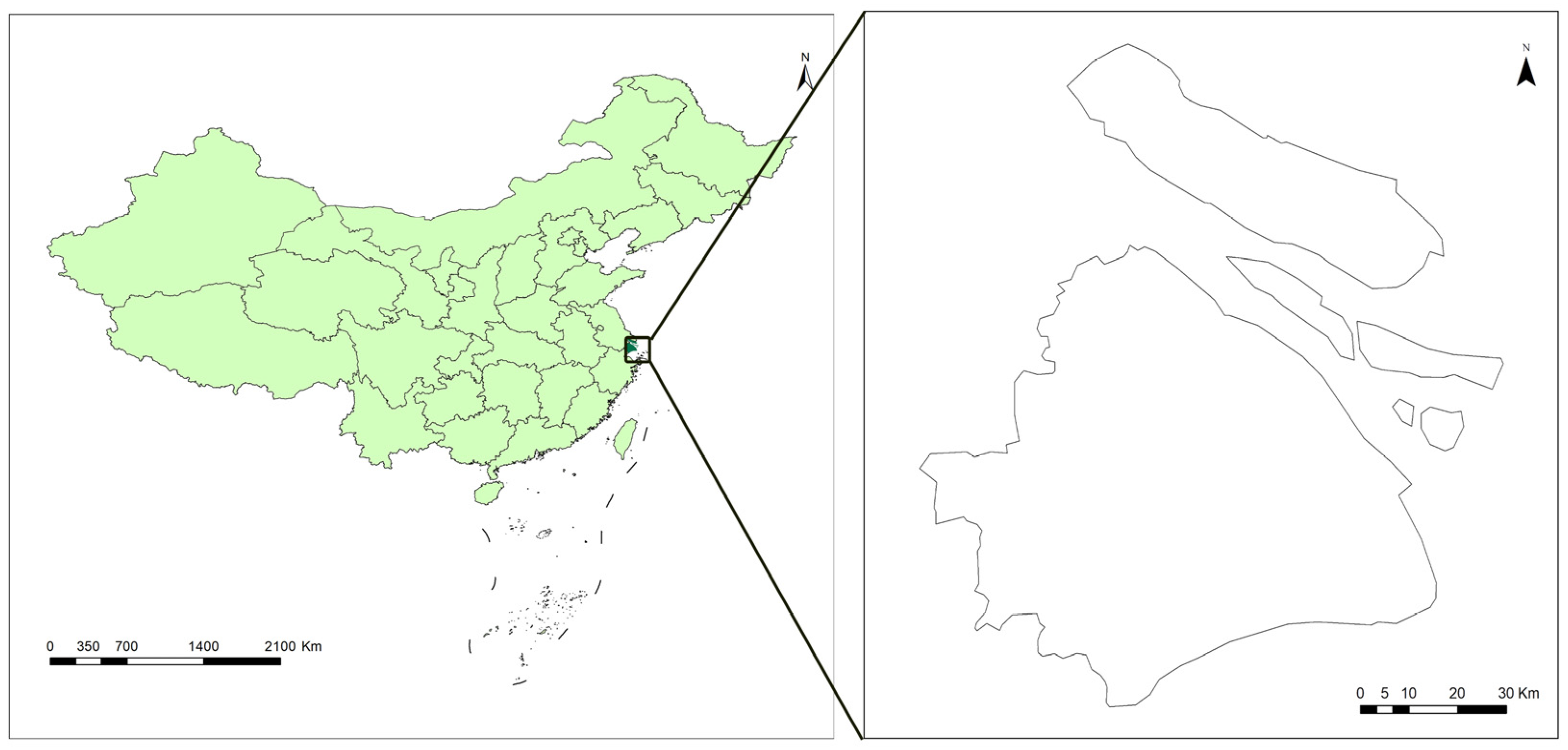
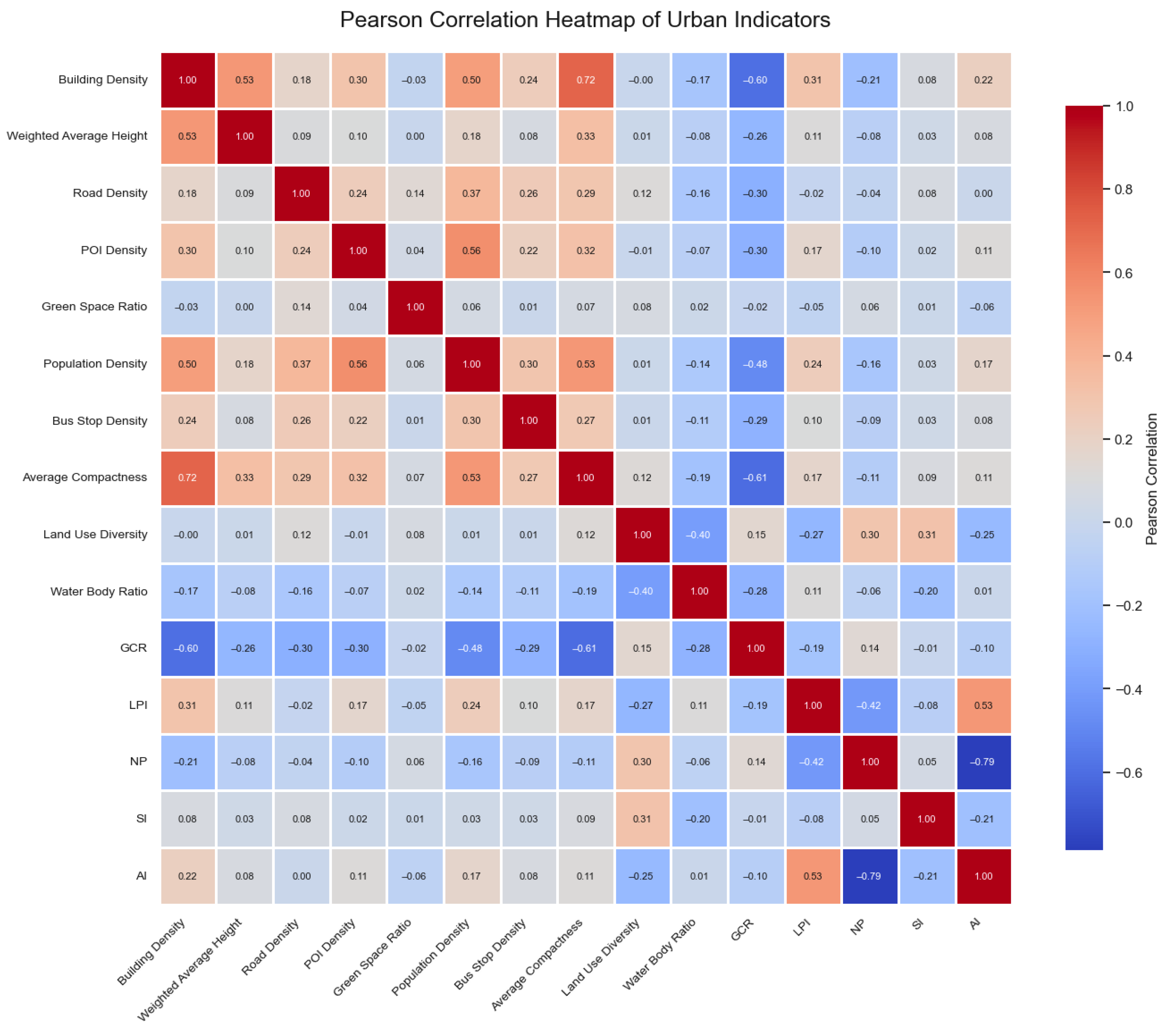
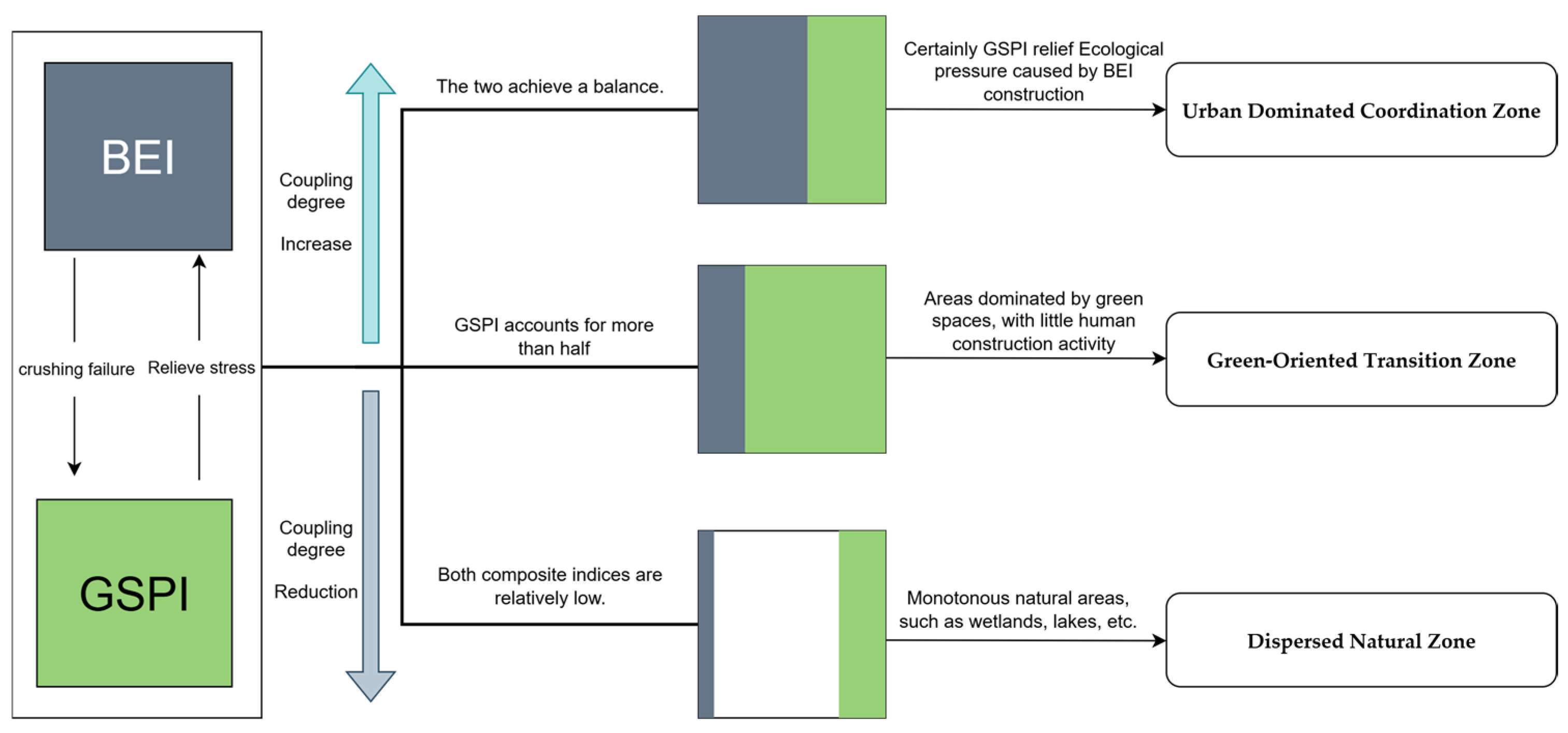
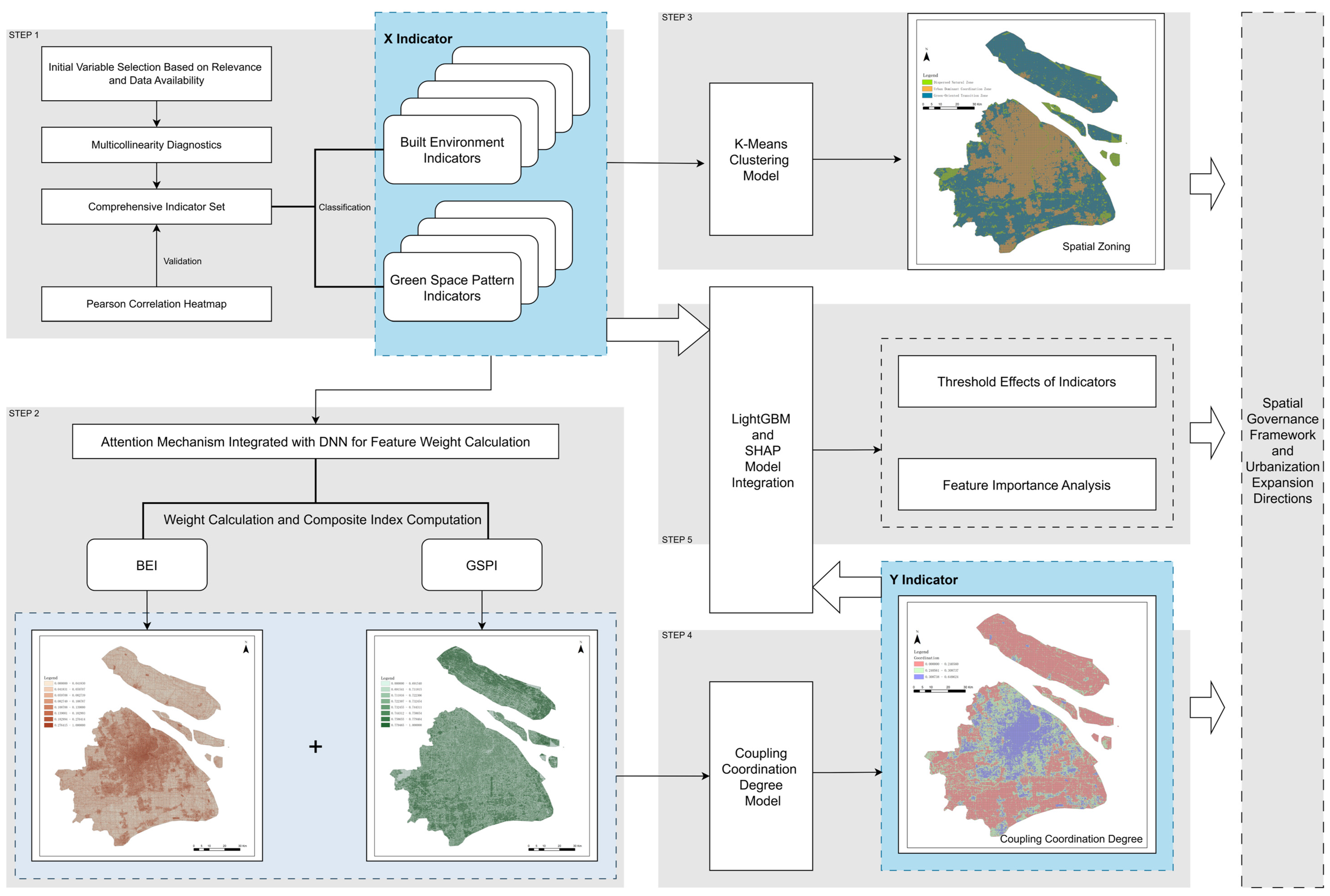


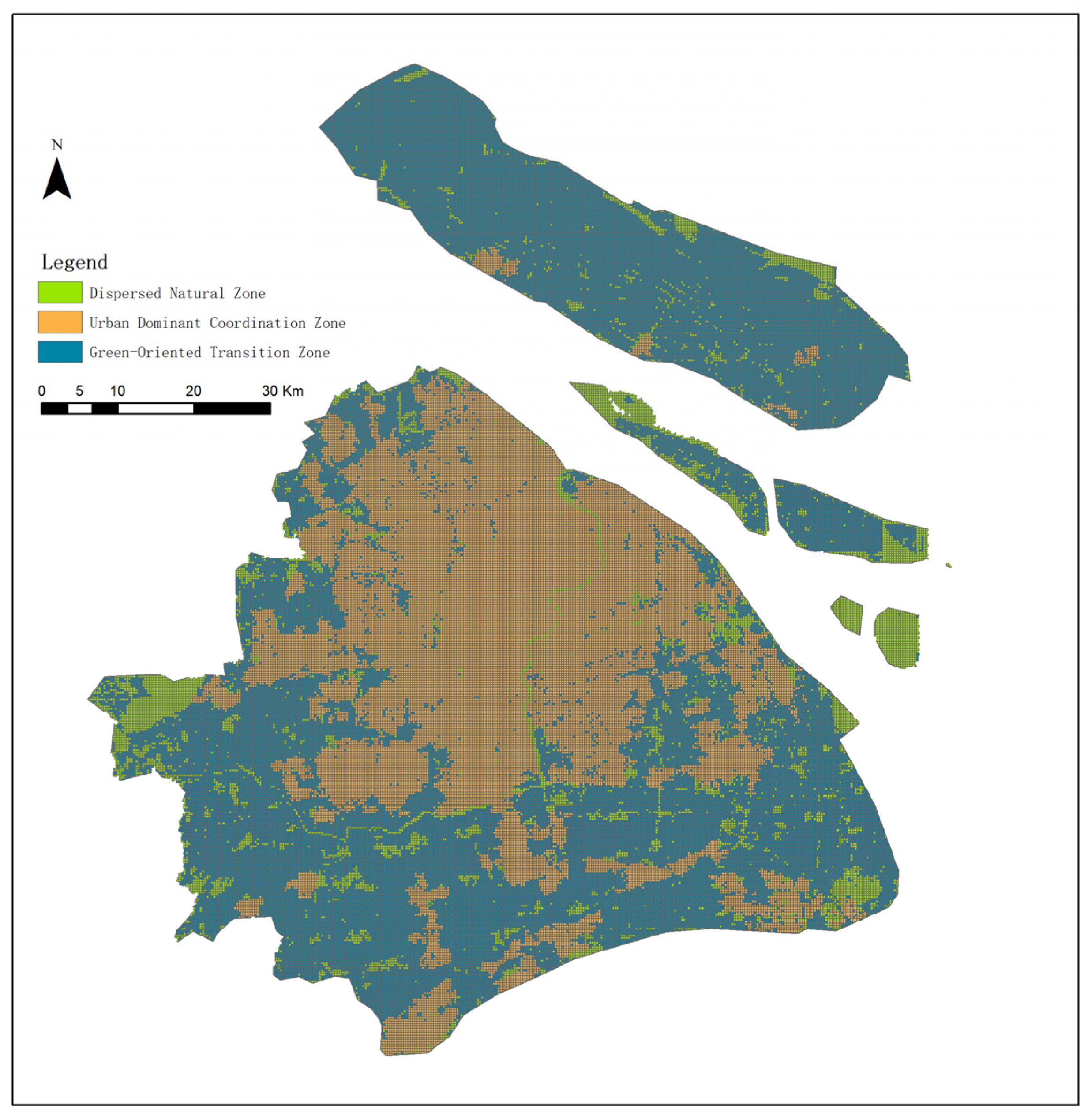


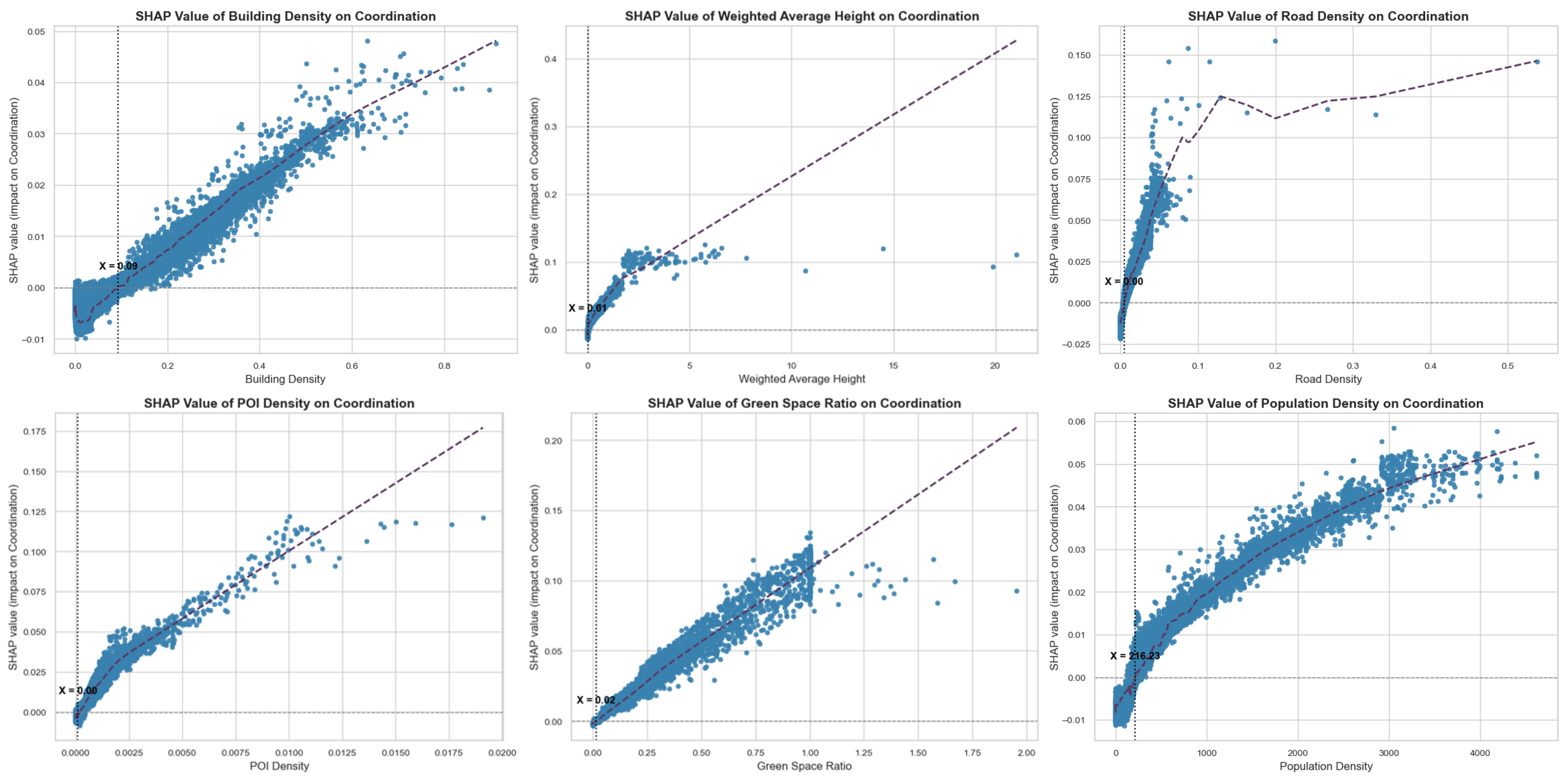
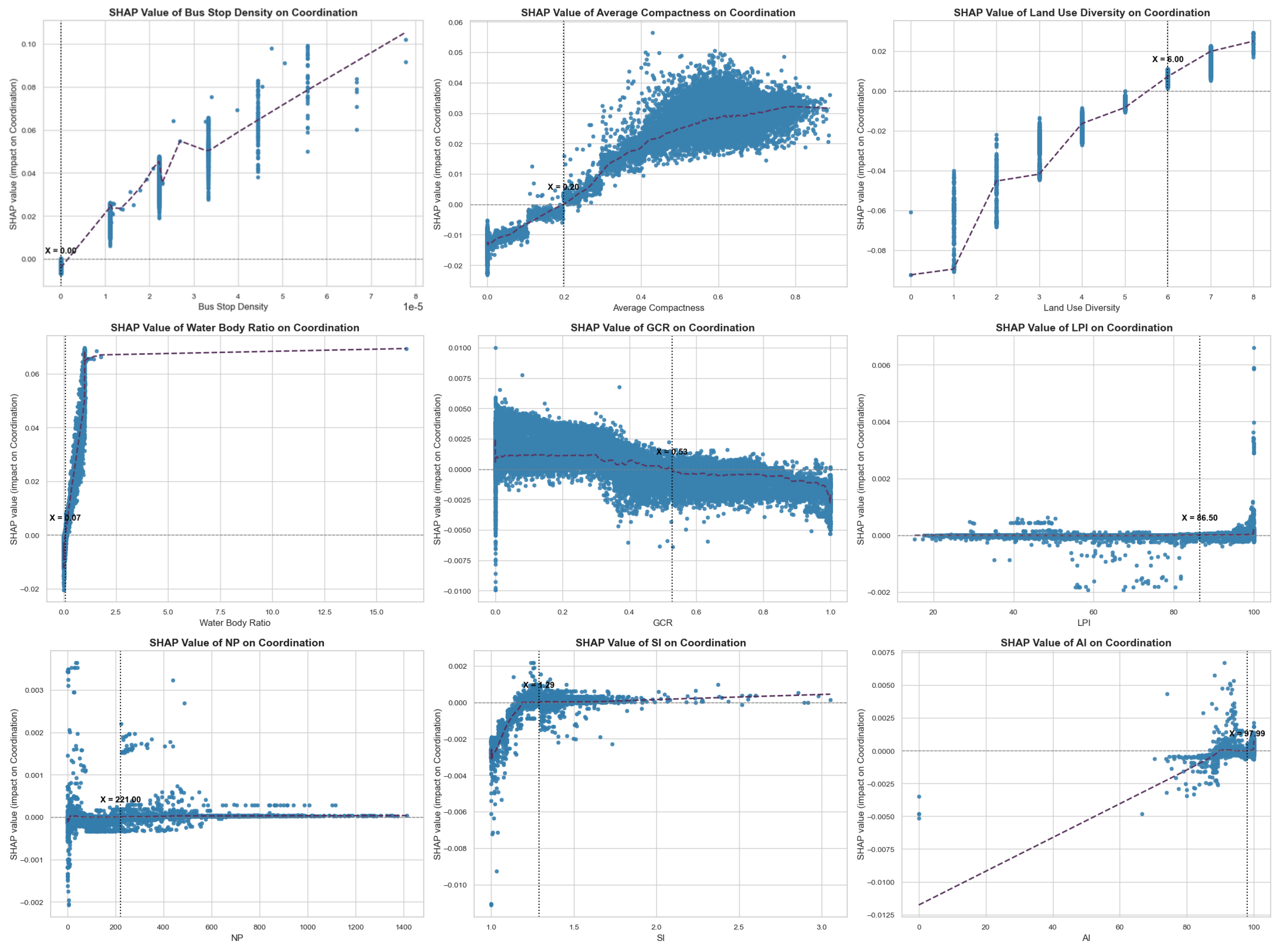
| Indicators | No. | Variable | VIF |
|---|---|---|---|
| Built Environment Indicators (BEI) | 1 | Building Density | 3.418191 |
| 2 | Weighted Average Height | 1.430039 | |
| 3 | Road Density | 1.342832 | |
| 4 | POI Density | 1.471579 | |
| 5 | Green Space Ratio | 1.043532 | |
| 6 | Population Density | 2.111864 | |
| 7 | Bus Stop Density | 1.189187 | |
| 8 | Average Compactness | 2.710779 | |
| 9 | Land Use Diversity | 1.488116 | |
| 10 | Water Body Ratio | 1.869330 | |
| Green Space Pattern Indicators(GSPI) | 11 | Green Coverage Ratio | 2.965984 |
| 12 | Largest Patch Index | 1.584769 | |
| 13 | Number of Patches | 2.914436 | |
| 14 | Shape Index | 1.237455 | |
| 15 | Aggregation Index | 3.330684 |
| Linear Regression | Random Forest | LightGBM | XGBoost | |
|---|---|---|---|---|
| MAE | 0.005321 | 0.002167 | 0.002086 | 0.002123 |
| MSE | 0.000088 | 0.000027 | 0.000024 | 0.000026 |
| RMSE | 0.009384 | 0.005216 | 0.004881 | 0.005097 |
| R2 | 0.973189 | 0.991717 | 0.992746 | 0.992090 |
| Residual plot | 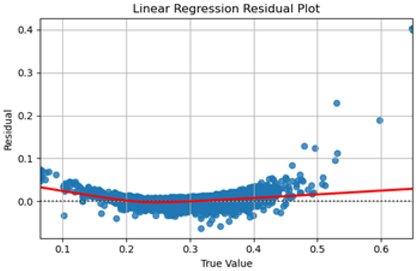 | 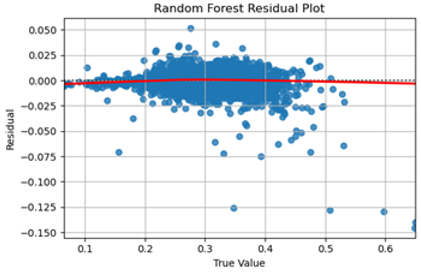 | 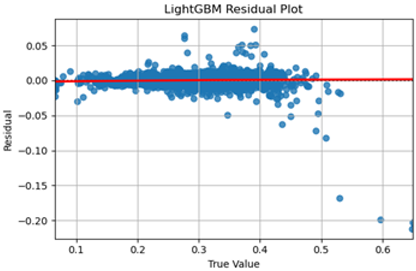 | 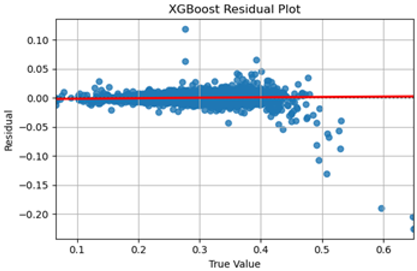 |
| Variable | Attention_Weight |
|---|---|
| Building Density | 0.09701068 |
| Weighted Average Height | 0.111377545 |
| Road Density | 0.082808815 |
| POI Density | 0.099431455 |
| Green Space Ratio | 0.10096676 |
| Population Density | 0.096694775 |
| Bus Stop Density | 0.11039864 |
| Average Compactness | 0.104573995 |
| Land Use Diversity | 0.08181346 |
| Water Body Ratio | 0.1149288 |
| Variable | Attention_Weight |
|---|---|
| Green Coverage Ratio | 0.212185 |
| Largest Patch Index | 0.269961 |
| Number of Patches | 0.121384 |
| Shape Index | 0.185129 |
| Aggregation Index | 0.211341 |
Disclaimer/Publisher’s Note: The statements, opinions and data contained in all publications are solely those of the individual author(s) and contributor(s) and not of MDPI and/or the editor(s). MDPI and/or the editor(s) disclaim responsibility for any injury to people or property resulting from any ideas, methods, instructions or products referred to in the content. |
© 2025 by the authors. Licensee MDPI, Basel, Switzerland. This article is an open access article distributed under the terms and conditions of the Creative Commons Attribution (CC BY) license (https://creativecommons.org/licenses/by/4.0/).
Share and Cite
Chen, R.; Chen, Z.; Xie, M.; Shi, R.; Chen, K.; Chen, S. Exploring the Spatial Coupling Characteristics and Influence Mechanisms of Built Environment and Green Space Pattern: The Case of Shanghai. Sustainability 2025, 17, 6828. https://doi.org/10.3390/su17156828
Chen R, Chen Z, Xie M, Shi R, Chen K, Chen S. Exploring the Spatial Coupling Characteristics and Influence Mechanisms of Built Environment and Green Space Pattern: The Case of Shanghai. Sustainability. 2025; 17(15):6828. https://doi.org/10.3390/su17156828
Chicago/Turabian StyleChen, Rongxiang, Zhiyuan Chen, Mingjing Xie, Rongrong Shi, Kaida Chen, and Shunhe Chen. 2025. "Exploring the Spatial Coupling Characteristics and Influence Mechanisms of Built Environment and Green Space Pattern: The Case of Shanghai" Sustainability 17, no. 15: 6828. https://doi.org/10.3390/su17156828
APA StyleChen, R., Chen, Z., Xie, M., Shi, R., Chen, K., & Chen, S. (2025). Exploring the Spatial Coupling Characteristics and Influence Mechanisms of Built Environment and Green Space Pattern: The Case of Shanghai. Sustainability, 17(15), 6828. https://doi.org/10.3390/su17156828









